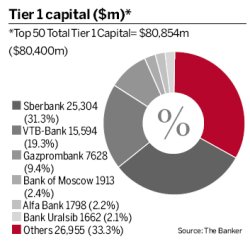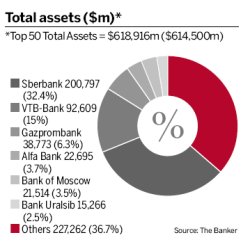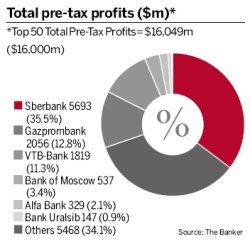The Russian banking sector has been transformed by the crisis in 2008, but signs of the change were already clear in the end-2007 data included in these rankings, as the difficulties of raising capital began to bite. Writer Philip Alexander.
Although the liquidity crisis that threatened the very stability of Russia’s financial sector did not take hold until mid-2008, there were already some clear trends by the end of 2007 that intensified in the turbulent year that followed. Above all, the strength of the three large state-owned banks – Sberbank, VTB-Bank and Gazprombank – has become more entrenched, with the top two more than doubling their Tier 1 capital ratios. These three banks control about 70% of Russian corporate and retail deposits, so when capital market funding became scarce in 2008, they retained the ability to grow their assets in a way that the rest of the sector will find difficult.
In practice, the capital base in the Top 50 banks is generally strong, with an average Tier 1 capital/assets ratio of 15.1% comparing very favourably to western Europe or the US. However, asset quality and liquidity have become the major concerns that can even threaten the solvency of Russian financial institutions (see pages 64 to 66).
For this reason, the profit-on-capital data should be treated with caution, as some of the most profitable banks in 2007 achieved their high returns by using a degree of leverage that has proven impossible to sustain. Credit card specialist Russian Standard Bank, with the third-best profit on capital in 2007 (at 37.9%), was downgraded one notch to ‘B+’ by Standard & Poor’s in November 2008, because of its difficulties in attracting funds for its growing credit portfolio. And Sviaz-bank, the second most profitable in 2007, with a return on capital of 41.3%, had to be bought out by the state development bank Vnesheconombank in September 2008, after failing to meet margin calls on the repo loans that it had collateralised with equities whose prices were plummeting. Another profitable mid-sized player, Sobinbank, similarly needed a state bail-out.
Nor did capital adequacy provide assurances. Globex Bank and KIT Finance, which both had to be rescued after similarly defaulting on repo loans when their own clients failed to make margin calls, were both among the top 25 soundest banks on a capital/assets basis in 2007.
Nonetheless, strong capital/asset ratios will provide some reassurance for investors, especially where banks are exposed to the more volatile retail lending sector. Natsionalnyy Reservnyy Bank appears to have achieved one of the most sustainable combinations, with a high profit on capital of 37.4% reached, while maintaining a strong 55.2% capital/assets ratio.
Foreign ownership
Another source of support to Russian banks will be foreign ownership, as foreign banks generally have better access to deposits, and higher credit ratings that are more likely to allow capital market access. Already, a number of foreign owners have made efforts to keep their Russian operations well capitalised. The Czech-owned consumer lending specialist, Home Credit and Finance Bank, which will be exposed to any rise in unemployment, should be relatively well protected by a capital/assets ratio of 18.4%, while the Russian subsidiary of Deutsche Bank is also in the top 25 for soundness.
It is likely that 2009 will present an opportunity for the banks with reliable access to funding to consolidate and increase market share, while some of the more leveraged players will disappear from the rankings.New ArrivalsThe Russian subsidiary of Germany’s Deutsche Bank enters the Top 50 in these rankings, although this is based on 2006 data available for the first time. Its status in the rankings hereafter is likely to depend on the parent bank’s commitment to expanding its presence in the Russian market. Similarly, Uniastrum Bank enters at 46, based on 2006 numbers. The bank’s exposure to retail loans may negatively affect its position when 2007 and 2008 data are available, but this may be partially offset by a strong focus on retail deposits – including accounts for expatriate Russians.The other three new entrants all provided 2007 data, and have entered the rankings based on the growth of their capital in that year. The most dramatic move came from Russ-Bank, which jumped into the rankings at 37, with a total capital base of $277m, after a capital increase of 1.5bn roubles ($45.5m) in 2007. The bank has been expanding aggressively in consumer lending, which could make it vulnerable to a downturn. However, its focus on mining and resources activity in Russia’s Far East, together with its close ties to the development programmes of regional governments, such as Buryatia and Perm, should prove stable sources of revenue.





